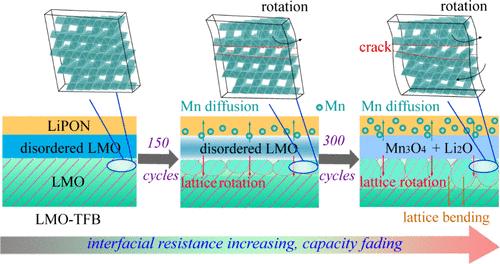全固态薄膜锂电池中LiMn2O4/LiPON界面退化的研究
IF 9.1
1区 材料科学
Q1 CHEMISTRY, MULTIDISCIPLINARY
引用次数: 0
摘要
尖晶石LiMn2O4 (LMO)是一种低成本的阴极材料,由于锰的溶解,其在液态电解质中的寿命有限,但有望通过抑制金属的溶解来改善其在固态电池中的应用。以LMO/LiPON/Li固态薄膜电池为模型系统,研究表明LMO在固体电解质中的循环稳定性明显差于液体电解质,其容量衰退机制与液体电解质完全不同。揭示了容量衰落源于LMO/LiPON界面的循环退化。LiPON沉积后形成界面无序的LMO层,不仅阻碍Li+扩散,而且成为应力集中区域。在循环过程中,靠近LiPON侧的界面层随着Mn向LiPON的扩散演变成非活性的Mn3O4/Li2O,而靠近LMO侧的界面层诱导晶格向内部LMO膜旋转,导致结构快速降解和容量快速衰减。本文章由计算机程序翻译,如有差异,请以英文原文为准。

Unraveling the LiMn2O4/LiPON Interface Degradation in All-Solid-State Thin-Film Lithium Batteries
Spinel LiMn2O4 (LMO) is a low-cost cathode with limited lifespan in liquid electrolytes due to Mn dissolution but is expected to be improved in solid-state batteries by suppressing metal dissolution. Using LMO/LiPON/Li solid-state thin film battery as a model system, we demonstrate that LMO shows considerably worse cycling stability with a solid electrolyte than a liquid electrolyte, and the capacity fading mechanism is entirely different from its liquid equivalent. It is disclosed that the capacity fading originates from the LMO/LiPON interface degradation with cycling. An interfacial disordered LMO layer is formed after LiPON deposition, which not only impedes Li+ diffusion but also becomes a stress-concentrated region. During cycling, the interfacial layer near the LiPON side evolves into inactive Mn3O4/Li2O together with Mn diffusion into LiPON, while the interfacial layer near the LMO side induces lattice rotation toward the interior LMO film, resulting in fast structural degradation and rapid capacity decay.
求助全文
通过发布文献求助,成功后即可免费获取论文全文。
去求助
来源期刊

Nano Letters
工程技术-材料科学:综合
CiteScore
16.80
自引率
2.80%
发文量
1182
审稿时长
1.4 months
期刊介绍:
Nano Letters serves as a dynamic platform for promptly disseminating original results in fundamental, applied, and emerging research across all facets of nanoscience and nanotechnology. A pivotal criterion for inclusion within Nano Letters is the convergence of at least two different areas or disciplines, ensuring a rich interdisciplinary scope. The journal is dedicated to fostering exploration in diverse areas, including:
- Experimental and theoretical findings on physical, chemical, and biological phenomena at the nanoscale
- Synthesis, characterization, and processing of organic, inorganic, polymer, and hybrid nanomaterials through physical, chemical, and biological methodologies
- Modeling and simulation of synthetic, assembly, and interaction processes
- Realization of integrated nanostructures and nano-engineered devices exhibiting advanced performance
- Applications of nanoscale materials in living and environmental systems
Nano Letters is committed to advancing and showcasing groundbreaking research that intersects various domains, fostering innovation and collaboration in the ever-evolving field of nanoscience and nanotechnology.
 求助内容:
求助内容: 应助结果提醒方式:
应助结果提醒方式:


